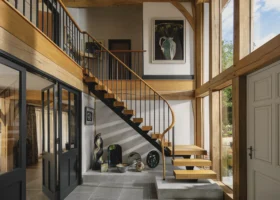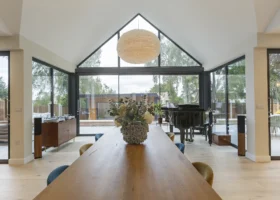The government has just confirmed what the new rules that allow extensions without planning permission will be – see below.
Unlike normal permitted development, a consultation and approval process is required, which sounds an awful lot like making a planning application.
There isn’t supposed to be a fee from the local authority for dealing with the approval process.
Given the stress put on planners as a result of the expenditure cuts this will probably go down with them like a lead balloon.
New Rules for Larger Home Extensions
For a period of three years, between 30 May 2013 and 30 May 20161, householders will be able to build larger single-storey rear extensions under permitted development. The size limits will double from 4 metres to 8 metres for detached houses, and from 3 metres to 6 metres for all other houses. These new larger extensions (i.e. if they extend between 4 and 8 metres, or between 3 and 6 metres) must go through the following process:
1. A homeowner wishing to build a larger single-storey rear extension must notify the local planning authority and provide:
a. a written description of the proposal which includes the length that the extension extends beyond the rear wall of the original house, the height at the eaves and the height at the highest point of the extension;
b. a plan of the site, showing the proposed development.
c. the addresses of any adjoining properties, including at the rear.
d. a contact address for the developer and an email address if the developer is happy to receive correspondence by email.
There is no fee in connection with this process.
2. The local authority may ask for further information if it needs it to make a decision about the impact of the development on the amenity of adjoining properties.
3. The local authority will serve a notice on adjoining owners or occupiers, i.e. those who share a boundary, including to the rear. This will give the address of the proposed development and describe it, including the information in 1(a) above. It will also set out:
a. when the application was received, and when the 42-day determination period ends
b. how long neighbours have to make objections (which must be a minimum of 21 days), and the date by which these must be received
A copy of this notice must also be sent to the developer.
4. If any adjoining neighbour raises an objection within the 21-day period, the local authority will take this into account and make a decision about whether the impact on the amenity of all adjoining properties is acceptable. No other issues will be considered.
5. The development can go ahead if the local authority notifies the developer in writing either:
a. that as no objections were received from adjoining neighbours it has not been necessary to consider the impact on amenity, or
b. that following consideration, it has decided that the effect on the amenity of adjoining properties is acceptable.
6. If the local authority does not notify the developer of its decision within the 42-day determination period, the development may go ahead.
7. If approval is refused, the developer may appeal.
8. The extension must be built in accordance with the details approved by the local authority (or, if no objections were raised or the local authority has not notified the developer of its decision, the details submitted), unless the local authority agrees any changes in writing.
9. The development must accord with all other relevant limitations and conditions which apply to other rear extensions allowed under permitted development. These are set out in Class A, and include for example, the requirement that the extension must be constructed using materials of a similar appearance to those used in the construction of the rest of the house.
10. To benefit from these permitted development rights, the extension must be completed on or before 30 May 2016. The developer must notify the local authority in writing of the date of completion.

































































































 Login/register to save Article for later
Login/register to save Article for later











